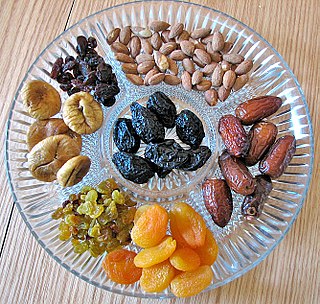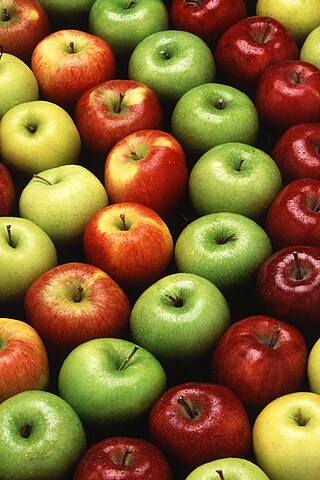Related Research Articles

A carbohydrate is a biomolecule consisting of carbon (C), hydrogen (H) and oxygen (O) atoms, usually with a hydrogen–oxygen atom ratio of 2:1 and thus with the empirical formula Cm(H2O)n, which does not mean the H has covalent bonds with O. However, not all carbohydrates conform to this precise stoichiometric definition, nor are all chemicals that do conform to this definition automatically classified as carbohydrates.

Glucose is a sugar with the molecular formula C6H12O6. Glucose is overall the most abundant monosaccharide, a subcategory of carbohydrates. Glucose is mainly made by plants and most algae during photosynthesis from water and carbon dioxide, using energy from sunlight, where it is used to make cellulose in cell walls, the most abundant carbohydrate in the world.

Xylitol is a chemical compound with the formula C
5H
12O
5, or HO(CH2)(CHOH)3(CH2)OH; specifically, one particular stereoisomer with that structural formula. It is a colorless or white crystalline solid that is freely soluble in water. It can be classified as a polyalcohol and a sugar alcohol, specifically an alditol. The name derives from Ancient Greek: ξύλον, xyl[on] 'wood', with the suffix -itol used to denote sugar alcohols.

Carbohydrate loading, commonly referred to as carb-loading, or carbo-loading, is a strategy used by endurance athletes, such as marathoners and triathletes, to maximize the storage of glycogen in the muscles and liver.

The glycemic (glycaemic) index is a number from 0 to 100 assigned to a food, with pure glucose arbitrarily given the value of 100, which represents the relative rise in the blood glucose level two hours after consuming that food. The GI of a specific food depends primarily on the quantity and type of carbohydrate it contains, but is also affected by the amount of entrapment of the carbohydrate molecules within the food, the fat and protein content of the food, the amount of organic acids in the food, and whether it is cooked and, if so, how it is cooked. GI tables, which list many types of foods and their GIs, are available. A food is considered to have a low GI if it is 55 or less; high GI if 70 or more; and mid-range GI if 56 to 69.

Dried fruit is fruit from which the majority of the original water content has been removed either naturally, through sun drying, or through the use of specialized dryers or dehydrators. Dried fruit has a long tradition of use dating back to the fourth millennium BC in Mesopotamia, and is prized because of its sweet taste, nutritive value, and long shelf life.
The glycemic response to a food or meal is the effect that food or meal has on blood sugar (glucose) levels after consumption. It is normal for blood glucose and insulin levels to rise after eating and then return again to fasting levels over a short period of time. This is particularly so after consumption of meals rich in certain carbohydrates. Glycemic management refers to the selection of foods to manage your blood sugar levels.
The glycemic load (GL) of food is a number that estimates how much the food will raise a person's blood glucose level after it is eaten. One unit of glycemic load approximates the effect of eating one gram of glucose. Glycemic load accounts for how much carbohydrate is in the food and how much each gram of carbohydrate in the food raises blood glucose levels. Glycemic load is based on the glycemic index (GI), and is calculated by multiplying the weight of available carbohydrate in the food (in grams) by the food's glycemic index, and then dividing by 100.

Tagatose is a hexose monosaccharide. It is found in small quantities in a variety of foods, and has attracted attention as an alternative sweetener. It is often found in dairy products, because it is formed when milk is heated. It is similar in texture and appearance to sucrose :215 and is 92% as sweet,:198 but with only 38% of the calories.:209 Tagatose is generally recognized as safe by the Food and Agriculture Organization and the World Health Organization, and has been since 2001. Since it is metabolized differently from sucrose, tagatose has a minimal effect on blood glucose and insulin levels. Tagatose is also approved as a tooth-friendly ingredient for dental products. Consumption of more than about 30 grams of tagatose in a dose may cause gastric disturbance in some people, as it is mostly processed in the large intestine, similar to soluble fiber.:214
Specific dynamic action (SDA), also known as thermic effect of food (TEF) or dietary induced thermogenesis (DIT), is the amount of energy expenditure above the basal metabolic rate due to the cost of processing food for use and storage. Heat production by brown adipose tissue which is activated after consumption of a meal is an additional component of dietary induced thermogenesis. The thermic effect of food is one of the components of metabolism along with resting metabolic rate and the exercise component. A commonly used estimate of the thermic effect of food is about 10% of one's caloric intake, though the effect varies substantially for different food components. For example, dietary fat is very easy to process and has very little thermic effect, while protein is hard to process and has a much larger thermic effect.

Isomaltulose is a disaccharide carbohydrate composed of glucose and fructose. It is naturally present in honey and sugarcane extracts and is also produced industrially from table sugar (sucrose) and used as a sugar alternative.

Agave syrup, also known as maguey syrup or agave nectar, is a sweetener commercially produced from several species of agave, including Agave tequilana and Agave salmiana. Blue-agave syrup contains 56% fructose as a sugar providing sweetening properties.
The Montignac diet is a high-protein low-carbohydrate fad diet that was popular in the 1990s, mainly in Europe. It was invented by Frenchman Michel Montignac (1944–2010), an international executive for the pharmaceutical industry, who, like his father, was overweight in his youth. His method is aimed at people wishing to lose weight efficiently and lastingly, reduce risks of heart failure, and prevent diabetes.
A diabetic diet is a diet that is used by people with diabetes mellitus or high blood sugar to minimize symptoms and dangerous complications of long-term elevations in blood sugar.

Postprandial somnolence is a normal state of drowsiness or lassitude following a meal. Postprandial somnolence has two components: a general state of low energy related to activation of the parasympathetic nervous system in response to mass in the gastrointestinal tract, and a specific state of sleepiness. While there are numerous theories surrounding this behavior, such as decreased blood flow to the brain, neurohormonal modulation of sleep through digestive coupled signaling, or vagal stimulation, very few have been explicitly tested. To date, human studies have loosely examined the behavioral characteristics of postprandial sleep, demonstrating potential shifts in EEG spectra and self-reported sleepiness. To date, the only clear animal models for examining the genetic and neuronal basis for this behavior are the fruit fly, the mouse, and the nematode Caenorhabditis elegans.
Michel Montignac was a French diet developer who originally created the Montignac diet to help himself lose weight, which he based on research that focuses on the glycemic index of foods, which affects the amount of glucose delivered to the blood after eating. The diet, which distinguishes between good and bad carbohydrates, became the basis for best-selling books and a chain of restaurants and stores promoting his diet regimen and was one of the theoretical predecessors of the South Beach Diet.
Dietary Reference Values (DRV) is the name of the nutritional requirements systems used by the United Kingdom Department of Health and the European Union's European Food Safety Authority.

Weight management refers to behaviors, techniques, and physiological processes that contribute to a person's ability to attain and maintain a healthy weight. Most weight management techniques encompass long-term lifestyle strategies that promote healthy eating and daily physical activity. Moreover, weight management involves developing meaningful ways to track weight over time and to identify ideal body weights for different individuals.
The following outline is provided as an overview of and topical guide to diabetes mellitus :
Satiety value is the degree at which food gives a human the sense of food gratification, the exact contrast feeling of hunger. The concept of the Satiety Value and Satiety Index was developed by Australian researcher and doctor, Susanna Holt. Highest satiety value is expected when the food that remains in the stomach for a longer period produces greatest functional activity of the organ. Limiting the food intake after reaching the satiety value helps reduce obesity problems.
References
- 1 2 3 Holt, Susanne H.A.; Brand-Miller, Janette Cecile; Petocz, Peter (November 1997). "An insulin index of foods: the insulin demand generated by 1000-kJ portions of common foods" (PDF). American Journal of Clinical Nutrition. 66 (5): 1264–76. doi: 10.1093/ajcn/66.5.1264 . PMID 9356547.
- ↑ Cousens, Gabriel (2008). There Is a Cure for Diabetes: The Tree of Life 21-Day+ Program. North Atlantic Books. p. 144. ISBN 978-1-55643-691-8.
- 1 2 Holt, Susanne H.A.; Brand-Miller, Janette Cecile; Petocz, Peter; Farmakalidis, E. (September 1995). "A satiety index of common foods". European Journal of Clinical Nutrition. 49 (9): 675–690. PMID 7498104.
- Mäkeläinen H, Anttila H, Sihvonen J, et al. (June 2007). "The effect of β-glucan on the glycemic and insulin index". Eur J Clin Nutr. 61 (6): 779–85. doi: 10.1038/sj.ejcn.1602561 . PMID 17151593.